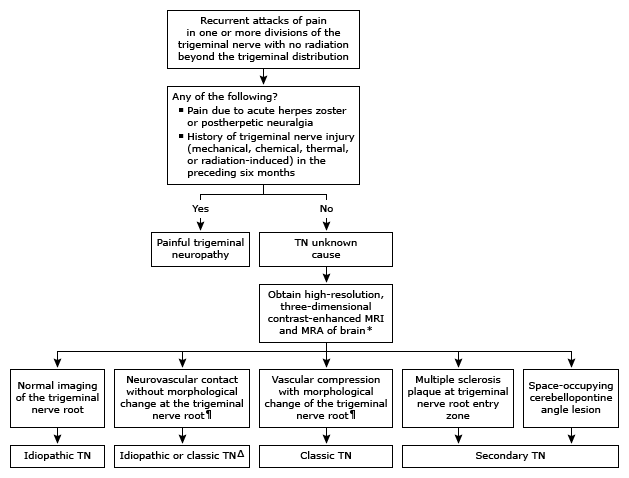INTRODUCTION
Trigeminal neuralgia (TN) is characterized by recurrent brief episodes of unilateral electric shock-like pains, abrupt in onset and termination, in the distribution of one or more divisions of the fifth cranial (trigeminal) nerve that typically are triggered by innocuous stimuli.
●Symptoms – Trigeminal neuralgia (TN) is defined clinically by sudden, usually unilateral, severe, brief, stabbing or lancinating, recurrent episodes of pain in the distribution of one or more branches of the fifth cranial (trigeminal) nerve that are triggered by stimulation of the affected trigeminal division.
●Diagnosis and evaluation – The diagnosis of TN is based upon the characteristic clinical features consisting primarily of brief paroxysms of severe pain in the distribution of the trigeminal nerve.
For all patients with suspected TN, we recommend neuroimaging to help define the underlying cause (algorithm 1). Magnetic resonance imaging (MRI) is the preferred imaging method because of its higher resolution compared with computed tomography (CT).

TN: trigeminal neuralgia; MRI: magnetic resonance imaging; MRA: magnetic resonance angiography.
Refer to UpToDate text for details of MRI and MRA sequences.
Morphological change includes dislocation, distortion, and/or atrophy of the trigeminal nerve root.
Mere contact without morphological change can be innocuous, but surgery may reveal compression or other morphological change not detected by MRI.
●Differential diagnosis – Uncommon causes of headache and craniofacial pain in the differential of TN include short-lasting unilateral neuralgiform headache attacks, cluster-tic syndrome, first bite syndrome, and primary stabbing headache. In addition, TN can sometimes be confused with dental causes of pain. Although less likely to be confused with TN, the differential diagnosis also includes various causes of painful trigeminal neuropathy, such as acute herpes zoster, postherpetic neuralgia, and trauma to the trigeminal nerve.
●Medical treatment – Pharmacologic therapy is used for initial treatment of most patients with TN.
•For patients with TN who require pain control, we recommend carbamazepine or oxcarbazepine as initial preventive therapy (Grade 1A). These agents have been shown effective in several placebo-controlled clinical trials.
•For patients with TN who are intolerant of or have contraindications to carbamazepine and oxcarbazepine, we suggest treatment with gabapentin, lamotrigine, or baclofen based on limited evidence of efficacy (Grade 2C). We add an agent from another pharmacologic class for patients with a partial response to monotherapy. Other experts advise early surgical referral for patients who fail to respond to first-line therapy.
Rescue therapy can provide short-term analgesia for patients with TN while oral medications are titrated or during breakthrough attacks. Available agents include intranasal or intravenous infusion of lidocaine, intravenous phenytoin or fosphenytoin, or subcutaneous injections of sumatriptan.
●Surgery for medically refractory cases – For patients with TN refractory to medical therapy, it is reasonable to discuss options for surgical therapy using microvascular decompression (for TN caused by compression of the trigeminal nerve root), various types of rhizotomy, or gamma knife radiosurgery. The decision to have surgery and the choice among surgical options will be influenced by individual circumstances including patient preference, adverse effect profile of the available techniques, and expertise of the local center.
You can find professional doctors and experts about this disease here for your further consultation and treatment.
Any use of this site constitutes your agreement to the Terms and Conditions and Privacy Policy linked below.
A single copy of these materials may be reprinted for noncommercial personal use only. "China-INI," "chinaini.org" are trademarks of China International Neuroscience Institute.
© 2008-2021 China International Neuroscience Institute (China-INI). All rights reserved.